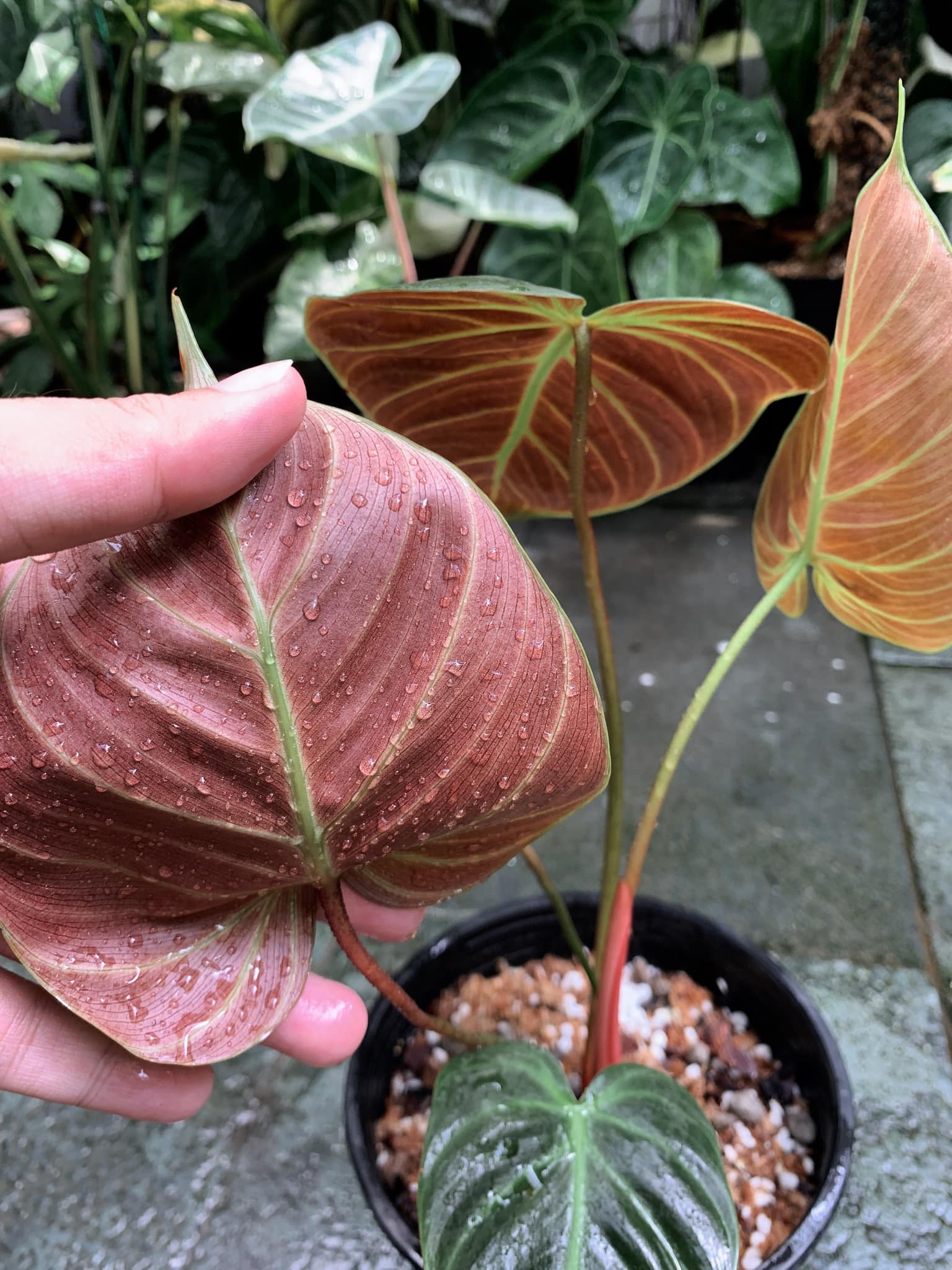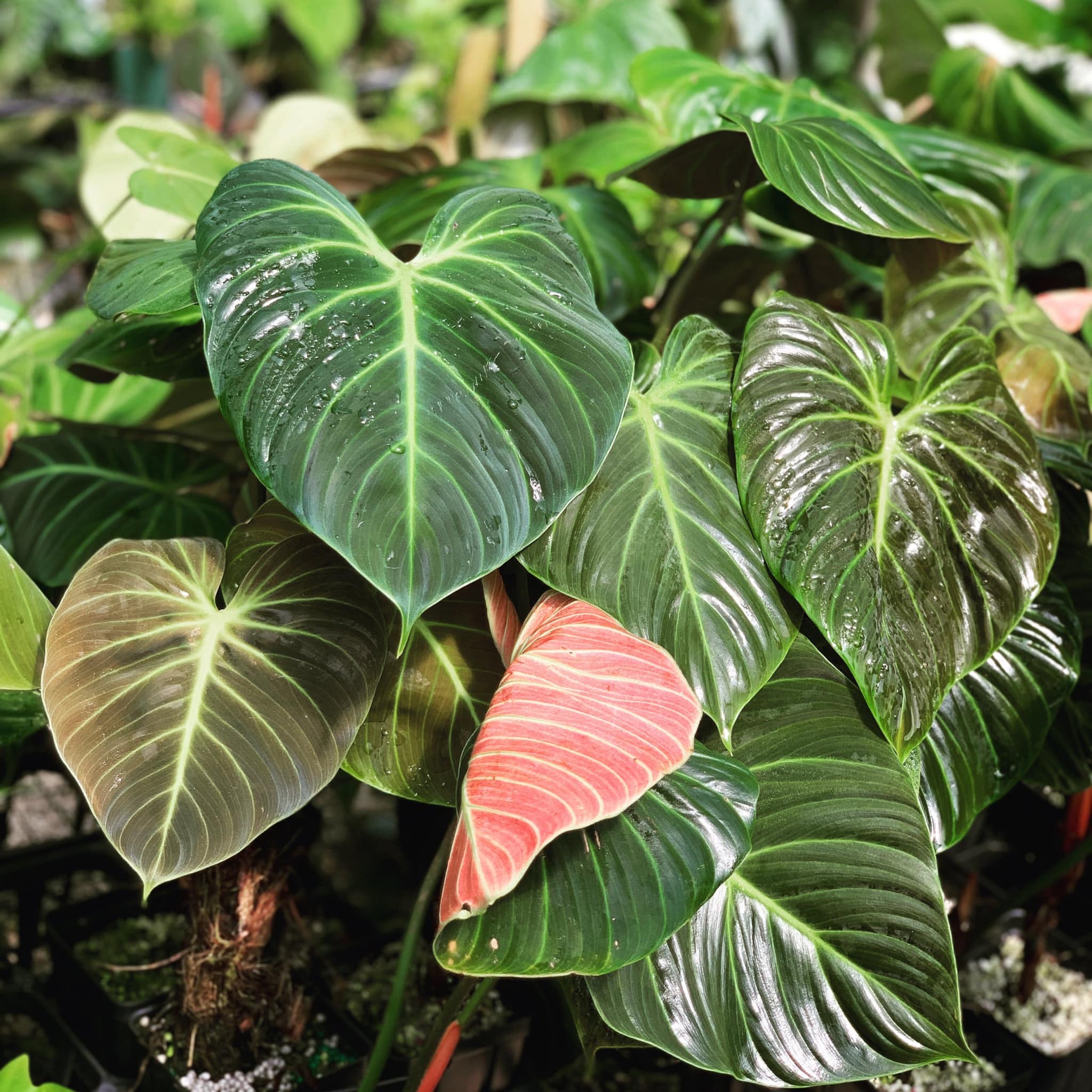Basic Information
The Philodendron El Choco Red is a climbing Aroid that is known for its large, heart-shaped leaves with a pop of color. When the plant is young, its leaves have bright red undersides. However, as it matures, its red coloring gradually fades to green. The leaves have a satin, almost velvety texture, and prominent light green veins.



Light
If you want to grow a Philodendron El Choco Red indoors successfully, you should create a semi-shade environment that receives filtered or bright indirect light. This plant is usually found growing under trees in tropical forests, so it is best to keep it in partial shade to maintain its vibrant colors and prevent growth from slowing down. Direct sunlight, especially in the afternoon, can damage the leaves, so avoid exposing the plant to it. Ideally, you should place the plant on an east-facing windowsill to balance light and shade perfectly. If you don’t have enough natural light, especially in winter, you can use grow lights to keep your plant healthy.
Water
To keep your Philodendron El Choco Red tropical rainforest plant healthy, it’s important to water it correctly, mimicking its natural rainfall patterns. These plants are epiphytic, which means they dry off quickly in the wild despite frequent rain. If you’re growing this plant home, water it thoroughly once the top two inches of soil are dry. However, letting the soil dry out slightly between watering is essential. In summer or a warm climate, you should water the plant several times a week. Conversely, you can reduce watering during winter since the soil stays moist longer due to colder temperatures. When watering, use a long-spouted watering can close to the soil and avoid watering overhead and splashing water on the foliage. Wet foliage creates an environment for fungi and pathogen growth, which is only higher for plants with large leaves like Philodendron El Choco Red.
Tip: It is recommended to use terracotta planters as they can help with better evaporation, and make sure that your pots have drainage holes to prevent waterlogging.
Soil
To ensure optimal growth of your plant, it is crucial to use a well-draining and airy potting mix. This can be achieved by mixing potting soil, orchid bark, perlite, and charcoal in ratios of 30%, 30%, 30%, and 10%, respectively. The ideal soil pH value is between 5.1 to 6.0. This combination helps maintain proper aeration and drainage while retaining essential nutrients. Charcoal is particularly useful in reducing impurities and pests. This mix supports your plant’s epiphytic nature, allowing the roots to access air and moisture effectively without being waterlogged.
Temperature
Philodendron El Choco Red prefers temperatures between 65 – 85 degrees F (18 – 29 degrees C). It does not tolerate cold well and is not frost-hardy. If grown outdoors, it should be in USDA hardiness zones 9b-11. Indoors, avoid placing the plant near cold drafts or heating sources that can cause temperature fluctuations.
Humidity
Maintaining humidity levels above 60% is essential for this plant’s proper growth and health. To increase humidity in your home, use a humidifier or place a pebble tray with water beneath the plant. Grouping plants together can also help to raise humidity levels naturally. However, it’s important to avoid leaving stagnant water on the leaves as it can lead to pest problems.
Fertilizer
Philodendron el choco red plants require essential nutrients like Nitrogen, Phosphorus, Potassium (NPK), Calcium, Magnesium, and Sulfur for their growth. Fertilizers provide these nutrients in different combinations and strengths, which are indicated by ratios like 10-10-20. However, over-fertilizing can be harmful, so it’s better to follow the principle of less is more. When fertilizing houseplants, use a balanced and gentle liquid fertilizer every month at half strength during Spring and Summer, but avoid fertilizing in Autumn and Winter. For Philodendron el choco red plants, fertilize every other watering at least three times a year. Keep fertilizers away from the base of the plant.
Growth Rate
This plant is a strong climber that can produce new leaves approximately every three weeks under ideal conditions. It’s recommended to provide support for its climbing habit with a moss pole or trellis, which helps to promote more considerable leaf growth. When grown indoors, it can reach a height of up to three feet (90cm).
Pet Safety
The Philodendron El Choco Red is toxic if ingested, so keep it away from pets and children to prevent accidental ingestion.
Grow in Semi-Hydro
- Philodendrons, celebrated for their lush foliage and adaptability, thrive in semi-hydroponic systems such as LECA/Pon, thanks to their resilient root systems and preference for consistent moisture.
- Shifting a Philodendron to a semi-hydroponic setting works well using a Nutrient Stagnant Wicking (NSW) method, providing a stable and effective environment for growth.
- Within the LECA/Pon environment, Philodendron roots adapt swiftly, effectively managing any early challenges in adapting to the NSW system.
- For nourishing Philodendrons in semi-hydro systems, a nutrient solution with a concentration around 800-1000ppm is optimal.
- Philodendrons are versatile in adapting to a range of temperature and humidity levels, making them ideal for various indoor settings.
- Regular care involves keeping an eye on the water level in the reservoir and periodically flushing the system to ensure the Philodendron’s healthy and consistent growth.
- If your Philodendron is a climber, it’s a must to look at our Moss Pole guide to have a proper set-up.
Tips
- Rotate the plant periodically to ensure even light exposure.
- Prune regularly to remove dead or yellowed leaves and to shape the plant. Use sterilized pruning tools to prevent disease transmission.
- Regularly inspect the plant for signs of pests and diseases.
- Wipe down the leaves with a damp cloth to keep them clean and efficient in photosynthesis.
- When repotting, do so in spring before new growth begins, and choose a pot about 3 sizes larger than the current one.
- Propagate through stem cuttings, placing them in water or well-draining soil to encourage root growth.
- Monitor soil moisture and water deeply, allowing excess water to drain
These detailed guidelines will help you maintain the health and beauty of your Philodendron El Choco Red.
Happy planting! 🌱


